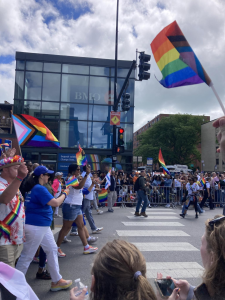Homelessness in America
December 5, 2012
Photo by Franco Folini
Photo by Ed Yourdonx.
Homeless and cold
Photo by Matthew Woitunskix
Homeless Man
Accurate rates of homelessness are difficult to obtain but USA Today recently estimated 1.6 million people used transitional housing or emergency shelters. The National Law Center on Homelessness and Poverty published a study in 2007 according to which approximately 3.5 million people, 1.35 million of them children, are likely to experience homelessness in a given year. Over the last decades, there has been a dramatic increase in homelessness. Rates tripled between 1981 – 89, according to a 1991 study by Urban Institute researcher Martha Burt. During the following decade, research conducted by the National Coalition for the Homeless showed that in nine out of eleven communities and three out of four states, shelter capacity doubled due to demand. A July 2012 analysis by Chicago Coalition for the Homeless (CCH) shows 105,338 Chicagoans were homeless in the course of the 2011-12 school year. CPS identified a record 17,255 homeless students in 2011-12, a 10.7 percent increase from the prior year’s record. Of this, 98.4 percent were children of color and 18 percent have been diagnosed with disabilities or development delays.
Chicago Homelessness
In 2003, Mayor Richard M. Daley endorsed a “10-Year Plan to End Homelessness” in
Chicago, which called for ultimately replacing the current system
that provides shelter to people on an emergency basis with a model to move individuals into permanent housing with support services. However, the 10-year plan failed to end homelessness and critics within the CCH claim that it should have included development of enough affordable housing
CCH was part of a 2005 study that found almost 25,000 Illinois youth experience homelessness each year. About one-third blamed family conflict. Other common reasons included physical or sexual abuse by a parent or family member. Three in five youth said they had been the victims of violence in the prior 12 months. Many said they were throwaways, not runaways, according to CCH.
Another CCH study showed that housing and support services succeed in helping overcome youth homelessness in 2007. It found that 87% who exited homeless youth programs moved into safe, stable housing. Yet due to an insufficient supply of shelter beds, programs were forced to turn away 52% of those who sought help, or 3,088 youth.
Demographics
A scan through the statistics shows how certain communities (veterans, disabled, LGBT youth, and those severely mentally ill) are invariably over represented among the homeless. The city of Chicago reported in 2011 that 10% were veterans, 15% were physically disabled, 4% were HIV positive, and 20% were severely mentally ill. According to a 2007 point-in-time count by the city of Chicago, the racial demographic of the homeless population was 75% African American, 16% white, 6% Latino, and 3% other ethnicity.
LGBT Youth
According to the Impact Program, based in Northwestern University,between 3 and 10 percent of the general population identifies as lesbian, gay, bisexual or transgender, according to the National Gay and Lesbian Task Force. However, a much larger percentage of the homeless youth population identifies as lesbian, gay, bisexual, or transgender – between 20 and 40 percent, as stated in the Task Force Report. The report states that, in Chicago alone, it is estimated that there are between 12,000 and 15,000 homeless youth. Between 1,448 and 3,000 of these youth are LGBT. LGBT youth are more likely to become homeless because of family discrimination. About 62 percent of homeless LGBT youth were discriminated against by their families, versus only 30 percent of heterosexual homeless youth, according to Center for American Progress. About half of LGBT youth who came out to their parents received a negative reaction and about 26 percent were kicked out of their family’s homes, according to the National Gay and Lesbian Task Force.
A social services infrastructure that gives preference to faith-based agencies has at times exacerbated some of the problems. After President George W. Bush issued an executive order permitting federal funding for faith-based organizations (FBOs) to provide social services in 2002, some have expressed concerns about how this has affected members of the LGBT community who are experiencing homelessness.
Additionally, faith-based programs tend not to offer mental health services as readily (9 percent of the time) as secular programs (22 percent). LGBT youth dealing with homelessness have a high risk of mental health problems, a greater likelihood of suicide and increased risks of unsafe sex, according to the National Alliance to End Homelessness. LGBT homeless youth are especially vulnerable to depression, loneliness and psychosomatic illness. Perhaps more critical, some studies have shed light on specific cases of homophobic staff at Covenant House in NYC, Salvation Army and Kentucky Baptist Homes for Children where transgendered homeless youth had to live in shelters listening to slurs and threats and gay youth were told by service providers that their homosexuality was at the root of their problems and that they should ‘simply stop being gay”.
How You Can Help
Due to stigma, most people struggling with homelessness will not volunteer the fact that they are and many will simply state that they are couch-surfing or use other euphemisms. At times, strong body odor may be the only sign of possible homelessness, in which case cautious, friendly questioning might confirm one’s hunch. Donations of meals, clothing, books, computers, CTA cards for people seeking employment and other basic needs items are of course always a good idea.
There are also numerous non-for-profit agencies, shelters, and food banks that serve the homeless or help to reduce the risk factors tied to homelessness. Volunteering or fund raising for these agencies is another way to contribute. Another way is to participate in the alternative economy and to increase awareness of it. For instance, due to an increase in under-employed citizenry, people who are unable to earn a living wage are turning to alternative models of exchange. There is a time bank in Chicago (the Chicago Time Exchange: http://chicago.timebanks.org/) where rather than using conventional currency goods and services are exchanged in units of time. By participating in these networks, people are able to exchange skills, goods, and services without cash: people living in poverty or who are uninsured are therefore able to afford doctors’ visits, dog sitting and other services that they would otherwise not have access to, with the added benefit of community-building which is inherent to complementary currency models.
There are many issues connected with homelessness, its prevention, and the public policies that worsen the problem. One of the major one is affordable housing, and this is where advocacy at the local neighborhood level may make a vast difference: one may contact the alderman or join forces with the local non-profit agencies that fight to keep housing affordable. And finally, consumption of goods made in the USA helps to keep wealth in the USA: the more local we consume, the better. Blind consumption is destroying American jobs and creating a demand for cheap labor elsewhere which is bad for labor abroad. If we as a society wish to once again be able to provide decent work with the dignity of a living wage to our citizens, this requires loyalty to companies with labor policies consistent with that vision.





